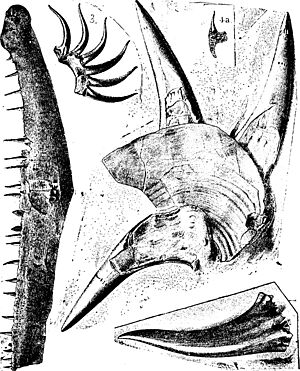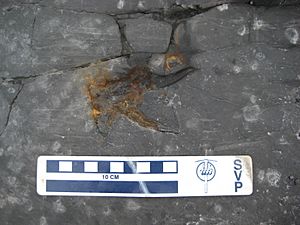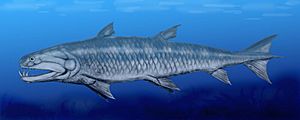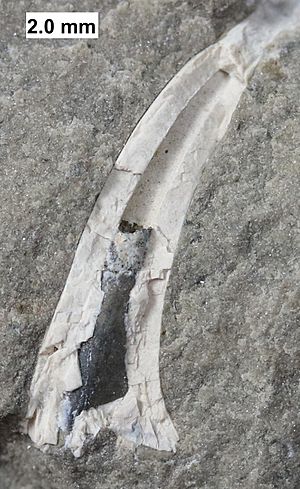Onychodus facts for kids
Quick facts for kids Onychodus |
|
|---|---|
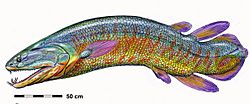 |
|
| Restoration | |
| Scientific classification | |
| Kingdom: | |
| Phylum: | |
| Subphylum: | |
| Class: | |
| Order: |
Onychodontida
|
| Family: |
Onychodontidae
|
| Genus: |
Onychodus
Newberry, 1857
|
| Species | |
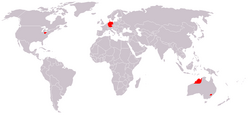 |
|
| Localities of known Onychodus fossils | |
Onychodus (which means "claw-tooth" in Greek) was a type of ancient lobe-finned fish. It lived during the Devonian period, about 374 to 397 million years ago. This fish is one of the most well-known members of a group called onychodontiform fishes.
Scientists first found scattered fossil bones of Onychodus in 1857 in North America. These fossils were described by John Strong Newberry. Later, other types of Onychodus were found in Australia, England, Norway, and Germany. This shows that Onychodus lived in many different places around the world.
Onychodus could grow to be about 2 to 4 meters (6.5 to 13 feet) long. It was a pelagic animal, meaning it lived in the open ocean, not near the bottom. Like other onychodontiforms, it had two special tooth spirals. These spirals held tusk-like teeth.
The best-preserved Onychodus fossil was found in the Gogo Formation in Western Australia. This fossil gave palaeontologists a lot of information about how the fish was built. Other types of Onychodus are only known from small pieces like single tusks, teeth, and scales.
Contents
What Onychodus Looked Like
The most special thing about Onychodus was a pair of hidden, flat tusks at the front of its lower jaw. These tusks were not attached to any other bone. Instead, they fit into deep holes in the roof of its mouth and could move freely.
The lower jaw was connected to the upper jaw in a unique way. When Onychodus raised its head, these tusk spirals would shoot out like a dagger. The upper jaw had about 30 teeth, which got smaller towards the back. Young Onychodus had six tusks, while adult fish had three.
One fairly complete Onychodus fossil from Western Australia was 47 cm (18.5 inches) long. Its head was 10 cm (4 inches) long, and its tusks were 1.2 cm (0.5 inches) long. This fish was only about half the size of larger Onychodus individuals. Some skulls found were 19 cm (7.5 inches) long. A single tusk found was 4 cm (1.6 inches) long, showing that some Onychodus were even bigger.
Scientists believe that Onychodus had an oval-shaped body. Along its sides, it had a row of pores. These pores were part of a sensory system. This system helped the fish find prey and move in tight spaces. Its tail fin was almost the same on both sides of its backbone. It was slightly rounded and very flexible, helping the fish swim forward quickly. A long fin extended along half of the tail fin, forming a second dorsal fin. The first dorsal fin is not fully known, but scientists think they found its support bone. On its underside, a large anal fin reached back under the front part of the tail fin. Onychodus had overlapping scales, ranging from 5 mm (0.2 inches) to 22 mm (0.9 inches) across.
How Onychodus is Grouped
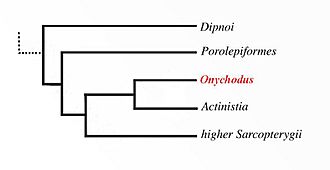
Onychodus is the main type of fish in the order Onychodontida and the family Onychodontidae. The family name 'Onychodontidae' was created for Onychodus by the British palaeontologist Arthur Smith Woodward in 1891.
The group of onychodontiforms was described in 1973 by Dr. Mahala Andrews. These fish had a very flexible skull and tusk-like teeth. Some scientists, like John A. Long, think Onychodus is closely related to another ancient lobe-finned fish called Psarolepis from China. Both Onychodus and Psarolepis are considered early bony fishes. This is because they don't have some key features found in coelacanths, lungfishes, and tetrapod-like lobe-finned fishes.
Discovering Onychodus Fossils
First Finds and Studies
The first Onychodus fossils were found in 1857 by Roy Wagner in Ohio, United States. These fossils were from the Middle Devonian period. These remains became the main example of Onychodus, later named Onychodus sigmoides. Geologist John Strong Newberry described and named it. One of his drawings of the findings was made by geologist Grove Karl Gilbert.
The name Onychodus sigmoides comes from the word "sigmoid," which means "S-shaped." This describes the shape of Onychodus's teeth. All species found had S-shaped teeth, but O. sigmoides was the first one described. The Onychodus fossil found by Wagner was given to the Orton Geological Museum at Ohio State University.
The fossils of Onychodus sigmoides included a lower jaw and other single pieces of bone, like parts of the skull. They were found near Ostrander, Delaware County, Ohio. All the bones were found separately because Onychodus's bones were loosely connected. They spread out quickly after the fish died. Studies show that Onychodus sigmoides was about 3 meters (10 feet) long. It was the largest known bony fish of the Middle Devonian period.
Later Discoveries
Onychodus jaekeli was the second species clearly identified as Onychodus. Fossils of this species were found in Germany and described by palaeontologist Walter Gross in 1965. Onychodus jaekeli had up to nine barbed tusks, all about the same length.
O. yassensis was found in New South Wales at the Canowindra site in Australia. These fossils were from the Late Devonian period. Palaeontologist David Lindley described this species in 2002.
The species Onychodus jandemarrai is the best-known type of Onychodus. It was found at the Gogo Formation in Kimberley, Western Australia. This species was described in 2006 after a lot of research by Dr. Mahala Andrews and her team. They used fossils collected by the British Museum of Natural History, the Bureau of Mineral Resources, and the Australian National University. Dr. John Long gathered new material from the limestone in the Gogo formation, which helped a lot. Even though we know a lot about this species, some parts are still missing. For example, we don't know the exact shape of the end of its tail, its pectoral and pelvic fins, or its first dorsal fin. The name O. jandemarrai comes from Jandemarra, an Aboriginal warrior who lived in that area.
Other less known species of Onychodus include:
- Onychodus anglicus (Woodward 1888) from England.
- Onychodus arcticus (Woodward 1889) from Spitsbergen, Norway.
- Onychodus hopkinsi and Onychodus ortoni (Newberry 1889) from North America.
- Onychodus obliquidentatus (Jessen 1966) from Rhenish Massif, Germany.
More recently, a new species called Onychodus eriensis (Mann et al., 2017) was described. It was found in the Dundee Formation of Pelee Island, Canada.
How Onychodus Lived
Many things we know about onychodont anatomy come from studying Onychodus. Like other onychodontiforms, it had a very flexible skull. This was unusual because the skull bones were loosely connected. They sometimes overlapped and were only held together by soft tissue and cartilage. Even its braincase was only partly made of bone.
Its special tusk spirals on the lower jaw were also unique. They could rotate, which was a different way for a jaw to work compared to other ancient fish. The lower jaw was connected by cartilage, allowing the bones to separate when it attacked prey. This loose connection also allowed side-to-side movement. When the mouth closed, the parts of the lower jaw would rotate inward. This made the tusk spirals fit perfectly into hollow spaces in the upper jaw. Scientists think a special ligament and muscle system helped pull the tusks back. This is a unique feature among animals with backbones. The way the lower jaw teeth fit with the upper jaw teeth kept the tusk spirals in place.
Hunting Strategy
Scientists believe Onychodus was an ambush predator. This means it would hide and then suddenly attack its prey. John A. Long suggested that Onychodus probably hid in the Devonian reefs. It would then lunge at other fish swimming by.
An interesting fossil of Onychodus from Western Australia was found with a placoderm fish stuck in its throat. The placoderm was half the length of the Onychodus! This amazing find was described by Dr. John A. Long.
The pectoral fins of Onychodus were strong. They might have allowed the fish to "walk" along the seafloor. This would help it search for hiding spots among coral colonies. Its back dorsal fin was very powerful. This gave it quick speed to catch prey.
- Two fossils of Onychodus hopkinsi, 1 & 2, at New York State Museum.
See also
 In Spanish: Onychodus para niños
In Spanish: Onychodus para niños


